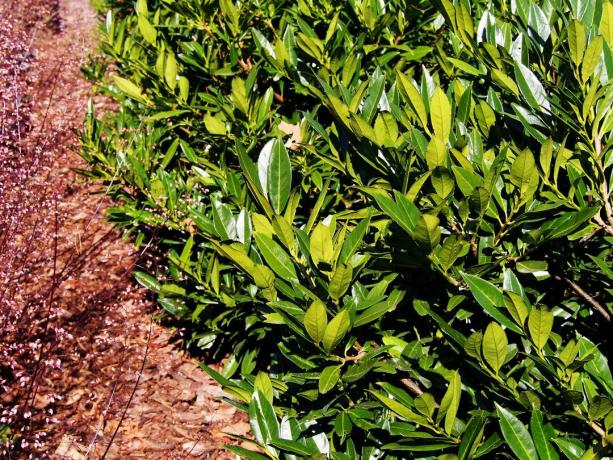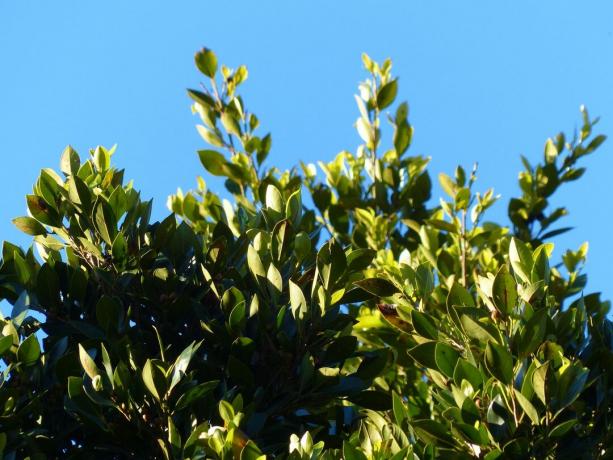The cherry laurel is one of the most popular hedge plants. But so that it grows so impressively, you should pay attention to a few things when fertilizing.

the cherry laurel (Prunus laurocerasus)is known for its rapid height growth and its evergreen leaves. In this way, you can quickly stop nosy neighbors from looking into your garden. But this evergreen vigor of the cherry laurel naturally needs support. The right location and sufficient fertilization are essential for it to be able to grow stately and healthily. Regular application of fertilizer also ensures that the trees are more resistant to diseases, drought and frost. In this article we will tell you what there is to consider when fertilizing cherry laurel.
contents
- When to fertilize cherry laurel?
-
Fertilizer for cherry laurel: fertilizer instructions
- Fertilize cherry laurel organically
- Fertilize cherry laurel with minerals
- Fertilize cherry laurel with home remedies
- Iron deficiency in cherry laurel
While fertilization isn't vital for a cherry laurel, you can get the most out of your evergreen garden dweller with the right nutrient supply. Because regular fertilization can make the difference between undergrowth and vigorously growing wood, especially on rather barren soils or with hedge plants. Therefore, we clarify all questions about the fertilization of the cherry laurel: when does it have to be fertilized? How often does it need to be fertilized? And which fertilizer is best for fertilizing a cherry laurel?
When to fertilize cherry laurel?
In the case of poor soil or bare-root plants, you can go directly to the Planting your cherry laurel a little horn shavings mix in the potting soil. Otherwise, the plant fertilization is omitted and maintenance fertilization only begins in the spring of the following year. Then you should supply the cherry laurel with nutrients at least once, better twice a year. This promotes rapid new growth and the evergreen shrub is adequately supplied even in winter.

You should fertilize before the start of the growth period so that your cherry laurel can put enough energy into new growth after the grueling winter. After that, a second fertilization in May or June is recommended, even when using a long-term fertilizer. Especially with fast-growing varieties like ˈCaucasiaˈ or ˈGenoliaˈ you should use fertilizer twice a year. If you like mineral fertilizer variants blue grain you should fertilize several times a year between February and the end of July in smaller doses about every four weeks. mineral fertilizers Although they act quickly, they are usually only available to plants for a very short time. It is therefore of no use to your cherry laurel if you fertilize with large quantities in reserve. On the contrary, the high concentration of nutrients very quickly leads to over-fertilization and damages your plant. In addition, excess nutrients are simply flushed out of the soil when watering and thus end up unnecessarily in the groundwater. For this reason, you should rather plant your cherry laurel with a organic fertilizer supply.
A nitrogen-rich fertilization in late summer is no longer recommended, as in this case you promote late budding. In itself, such a promotion is exactly what fertilization is supposed to achieve, but the young shoots no longer have enough time to harden sufficiently before the first frost. The result would be significant frost damage. Instead of the nutrient bomb, autumn fertilization is better in late summer potassium fertilizer for use. This increases the resistance of the leaves to frost damage.
Summary: when to fertilize cherry laurel
- In the case of poor soil or bare-root plants, fertilizing with horn shavings is recommended
- In the spring after planting, you should start with the first maintenance fertilization
- Long-term fertilizers are applied once or twice a year; the first time before the start of the growing season and the second time in May or June
- Mineral fertilizers are used in small doses every four weeks between February and late July to avoid over-fertilizing
- A potassium fertilizer is used for autumn fertilization in late summer, which increases the resistance of the plant
Expert tip: If you need to prune your cherry laurel radically, you should feed it with a good dose of slow release organic fertilizer like ours first Plantura organic universal fertilizer supply, because the budding after pruning requires an enormous amount of energy.
Fertilizer for cherry laurel: fertilizer instructions
Special cherry laurel ready-to-use fertilizers optimally supply your plants with nutrients. In this way they guarantee good growth and the long-term preservation of the leaves. However, you do not necessarily have to resort to a special fertilizer, even one universal fertilizer supplies your cherry laurel with the most important nutrients. The fertilizer you choose should have a balanced ratio of potassium and nitrogen and a slightly lower proportion of phosphate. Just as with the special fertilizer, pay attention to a fertilizer with organic components - for example ours Plantura organic universal fertilizer. Not only are you doing nature a favour, your cherry laurel will also be cared for more gently and over the long term in this way and will stay with you longer. Because the nutrients in organic fertilizers are in a complex form. In this way, the nutrients are only slowly released into the surrounding soil, which also promotes soil life. This is particularly important for plants that stay in one place for a long time, because friendly helpers like the earthworm counteract soil compaction. However, organic fertilizers do not only have a positive effect in your own garden. Compared to mineral fertilizers, these already have a significantly better environmental balance during production. This is because the production is much less complex and uses far fewer resources.

Fertilize cherry laurel organically
The best fertilizer for cherry laurel is organic (slow acting), potash rich (promotes drought resistance and hardiness), and applied at least once a year. Horn shavings mixed with mature compost or manure as a supplier of nutrients and minerals, will optimally supply your plant throughout the year. Simply mix a handful of horn shavings with two to three liters of mature compost or manure. This nutrient mix is superficially worked into the soil in the root area. Then cover the whole thing with a fresh layer of soil to encourage the decomposition process. Horn meal or horn shavings provide your cherry laurel with sufficient nitrogen and are particularly well suited for long-term supply. Incidentally, you can recognize a nitrogen deficiency by the uniform yellowing of the leaves.
However, organic complete fertilizers from specialist shops are also a good alternative to natural fertilizers, which are rather difficult to obtain, especially in urban areas. This is how you care for your cherry laurel in an environmentally friendly way that saves time and odor. Our Plantura Organic universal fertilizerprovides your cherry laurel with all-round care - and with almost exclusively organic components. In this way you offer your plants an environmentally friendly supply that boosts plant growth and soil life. After fertilization, the soil around the cherry laurel is mulched with lawn clippings, bark mulch or wood chips. The mulch layer does not alone provide an additional supply of nutrients when it decomposes. It also has an insulating effect, protects against evaporation and inhibits weed growth.

Organic long-term fertilization: instructions and application rates for cherry laurel
Even if the handling of predominantly organic fertilizers is associated with significantly fewer risks than that When using a mineral fertilizer, correct application is essential for optimal care of your cherry laurel. With our guide to deploying our Plantura organic universal fertilizer However, the correct handling of the fertilizer should not be a problem at all:
- Before planting, work 100 - 150 g/m² (well-filled 0.2 liter glass) of our Plantura organic universal fertilizer into the top layer of soil.
- Pour the base and freshly added cherry laurel well so that the granules can dissolve well.
- For maintenance fertilization in spring and in May/June, you should fertilize another 80 - 120 g/m² (0.2 liter glass) per plant.
Fertilize cherry laurel with minerals
You can also bring your cherry laurel with you blue grain or other mineral complete fertilizers supply. These contain everything for good growth of the evergreen shrub. However, make sure you dose these fertilizers accurately. Otherwise, you risk over-fertilizing your cherry laurel. This not only harms the plant, but also soil life and groundwater. It is therefore better to fertilize regularly and in small doses. As already mentioned, fertilizing with organic fertilizers is simpler, safer and more environmentally friendly. These are completely sufficient for the frugal cherry laurel.

Fertilize cherry laurel with home remedies
Home remedies are not only a successful alternative to store-bought remedies for spring cleaning. Plants are also happy about one or the other variant that grandma already knew. There are wonderful opportunities to fall back on finds from household waste, especially when maintaining the correct soil pH value. If this value is too high, the Fertilization with coffee groundsnot only for an extra load of nitrogen, the set also has an acidifying effect. However, if the pH drops too far into the basement, giving crushed ones will help eggshells as fertilizer. These contain a lot of lime and drive the soil pH value up again. If you want to make horn shavings yourself, simply collect large amounts of hair and nails. These consist of the same material as horn.
Iron deficiency in cherry laurel
If your cherry laurel develops yellow leaves with green veins, this is probably due to an iron deficiency. The administration of an iron chelate fertilizer helps here. However, before you resort to iron fertilizer, you should check the pH of the soil. This should be between 5 and 7.5 for the cherry laurel. If the pH is too high, iron cannot be absorbed as it is in the soil in its insoluble form. In order for the iron to become available again, the soil must be acidified. You can achieve this, for example, by fertilizing compost from oak leaves or add some coffee grounds to the fertilizer of your choice. If you already know at the time of planting that the soil at the planting site is quite basic, you can also mix in coniferous soil with the potting soil. This is soil from the immediate vicinity of conifers.
Regular pruning is also an important care measure for cherry laurel. How and when your Cut cherry laurel should, you will find out in this article.

